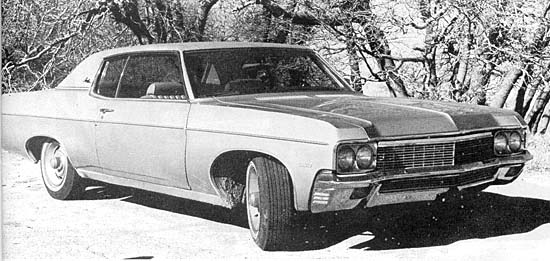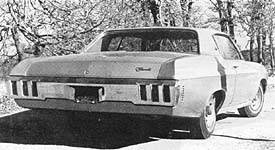
Impala -- the family man's family car

| Chevrolet makes a line of big cars which are, for all practical purposes, interchangeable. The Impala comes in the most variations, five, with the Caprice, Biscayne, and Bel Air in two each, and with a batch of station wagons sold under pseudo-aristrocratic nameplates. They are all on the same chassis with its 119-inch wheelbase, and are 216 inches overall. There are minor dimensional differences in the station wagons, but they are of minor importance, too.
Little changed from last year, the Impala can be bought as a 4-door sedan and a 2-door sport coupe for about $3300 base, as the Custom Coupe we tested or a 4-door sport sedan for $3400, and as the convertible for about $3600. These prices would be with the 250-horsepower 350-cubic-inch V-8 engine as in the test car. You wouldn't end up with anything close to our test car for these prices mind you. It had close to $1300 in options in and on it, taking the total up to $4714.15 - plus tax and license. Say $5000 as an eyeball figure. The items on the options list of major expense were the 300-horse engine at $200, the power windows at $105, the vinyl roof cover at $105, the air conditioning at $384, and the power steering at $105. It's odd how that figure keeps repeating and, to be more precise, right at $105.35. |
 Rear overhang is five feet, but upswept tail gives good clearance. Test car had optional "Rally Wheels" with belted tires. |  The grille is considered as one of the best of the season, but there is some doubt as to how well the bar section in the bumper will hold up in parking lots. |
| You may be happy to know that even the base Impala Custom Coupe comes with Astro ventilation, Hide-a-Way wipers, wood-grained interior accents, lighter, glove compartment light, carpeting, front seat back latches, front shoulder belts, wheel opening moldings, luggage compartment mat and light, head restraints, and power front disc brakes. |
| Drive train The two standard engines for the Big Chevies are the 155-hp Turbo-thrift inline 250 cu. in. six and the 250 hp Turbo-Fire 350 V-8. Except that the six is not available on the Caprice models, the Impala Custom Coupe, Sport Sedan, or Convertible. The optional and extra cost engines include the 300 hp 350 cu. in. as in our test car, a 265 hp 400 cu. in. regular gas V-8, a 345 hp 454, and a 390 hp 454. The 400 has replaced last year's 396 cu. in. option, and the 454 has replaced the 427, with the horsepower rating staying almost identical. |  Six engines are available for the big Chevy cars, with the 300 horsepower 350 cubic inch V-8 in the test car the most popular of all. |
| Transmissions include the standard 3-speed manual, the 2-speed Powerglide automatic, and the 3-speed Turbo Hydramatic automatic, with the 4-speed manual not listed this year. The clutch on the lesser-powered Impalas is a 10.34 inch model, going to 11.0 inches with the 300 hp 350 cu. in. engine. All are a single dry disc, woven asbestos plate with a diaphragm pressure plate. Eight different rear axle ratios are available throughout the Chevy Big Car series, from 2.29:1 to 3.55:1. Our test Impala had the trailer-towing 3,31:1 rear.
The availability of the three transmissions shows a trend away from any true high-performance image-making in the Big Chevy line. With the 4-speed manual dropped, the 3-speed can only be had with the two standard engines - the in-line 6 and the 250 hp V-8. The 2-speed Powerglide can be had with these two engines, plus the 300 hp 350 cu. in. V-8. The 3-speed Turbo Hydra-Matic can be had with any of the standard or optional engines. Power and performance The more-or-less middle of the road 300 hp engine in our test Impala was more than adequate for every driving condition that we subjected it to. We drove it on freeways with their high speeds, and over rutted mountain roads where we seldom reached 20 miles an hour. While the Impala was most certainly built more for freeways and city streets, we found no fault with it on dirt roads aside from the undeniable fact that it is a big car. Even such a car as this, particularly with the heavy-duty "F40" suspension on the test car, will take you almost anywhere if you drop the Hydra-Matic down into a low range and take your cotton-picking time. We had one problem on the test car. In switching in that 3.31:1 rear ratio for trailer towing, GMC didn't bother to change the speedometer gearing. This made for some hilarious acceleration figures, getting to 45 mph in five seconds, and the like. We finally had to mark the speedometer glass with a grease pencil to remind ourself that 62 mph was really 50, 72 was 60, 84 was 70, and 94 was 80. The first day we had the car we were shaking our head over how little feeling of acceleration and speed there seemed to be. Even with the rather odd rear-end ratio, times at the drag strip weren't all that bad. We did the standing-quarter in a little over 16 seconds, with a speed through the traps of 81 mph - while indicating 95 mph, of course. Braking was particularly impressive for this large, 4200-pound car, with a stop from 60 mph in 138 feet. This is 30 to 40 feet shorter than the average Detroit barge, and is a product of the wide tires and the large brakes. |
| Happily front disc brakes are standard equipment on the Impala Custom Coupe - and the Caprice and Kings Estate station wagon - with 11-inch finned drums on rear. We did a bit of high-speed driving along a winding mountain road, landing on the brakes both hard and late as we took the turns. No sweat at all. They slowed the Impala down fast and true everytime, with no sign of fading. In buying any of the Big Chevies that don't have the disc brakes on the front as standard equipment, the $64 they cost as an option is certainly a worthwhile investment. |  Front disc brakes are optional on all the Big Chevrolets, but are standard on the Impala Custom Coupe - and Caprice Coupe and Sedan. |